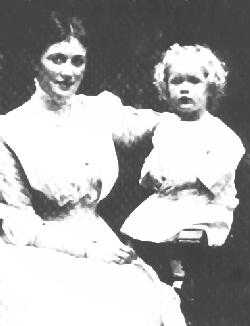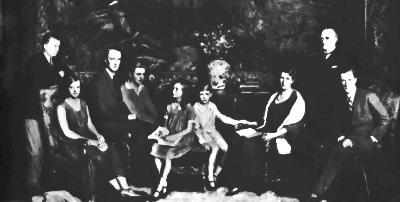
Figure 1.--Bertha Krupp in 1909 with 2-year old Alfred.
The Krupp family will for ever be associated with the manufacture
of munitions in the 19th and 20th centuries. The Krupps were a
major supplier of the Prussian, Imperial, and NAZI armed forces. But
more than supply the NAZIs they helped bring them to power and during
the War profited from the horrendous exploitation of slave labor.
The Krupp saga is a case study in 19th century industial development.
Some of the most important members of the family are listed below.
Friedrch Krupp (1787-1826) founded the Krupp family corporate
empire. He was a German iromaster who established a small forge at
Essen in 1810 and experimented with the making of a cast steel. Later
he built a small plant of eight smelling furnaces.
Alfred Krupp (1812-87) son of Friedrich. He developed the
process of making cast steel begun by his
father. In 1847 he made a 3-pounder muzzle-loading gun of cast steel, and in 1851
he exhibited at the Great Exhibition in
London a solid, flawless ingot of cast steel,
weighing more than 2 tons, which brought
him international renown. Krupp artillery
and breach-loading rifles, adopted by the
Prussian Army in 1861, proved their superiority to conventional weapons in the siege
of Paris during the Franco-Prussian War in

Figure 1.--Bertha Krupp in 1909 with 2-year old Alfred. |
Frederich Alfred Krupp (1854-1902), son of Alfred. He devoted himself to
the financial side of the business and expanded the Krupp interests tremendously.
He acquired other steel plants, coal and iron
mines, and the great Germania shipyard at Kiel.
Bertha Krupp (1886- ) the daughter of Friedrich Albert. She inherited
the Krupp holdings from her father. In 1906
she married Gustav von Bohlen und Halbach.
Gustav Von Boulek und Halbach (1870- ), husband of Bertha Krupp. He took the name Krupp von Bohlen und Halbach, and became head of the Krupp firm. During the years before World War I the Krupp works supplied armor plate and guns for new ships in the rapidly expanding German highseas fleet, and became internationally famous for the manufacture of heavy siege mortars and long-range cannon. He was one

Figure 2.--Bertha, 5-year old Alfried, and Gustav rehearsing for the Krupp centennial tournamet in 1912. |
Alfred Krupp von Bohlen und Halbach, son of Gustav Von Boulek und Halbach, succeeded his father as head of the business in 1942. He was also indicted. Alfred was convicted of plundering occupied

Figure 3.--Bertha and Gustav with their children in 1931. The two younger children are Waldtraut and Eckbert. |
Navigate the Boys' Historical Clothing Web Site:
[Introduction]
[Chronology]
[Clothing styles]
[Biographies]
[Bibliographies]
[Contributions]
[Boys' Clothing Home]